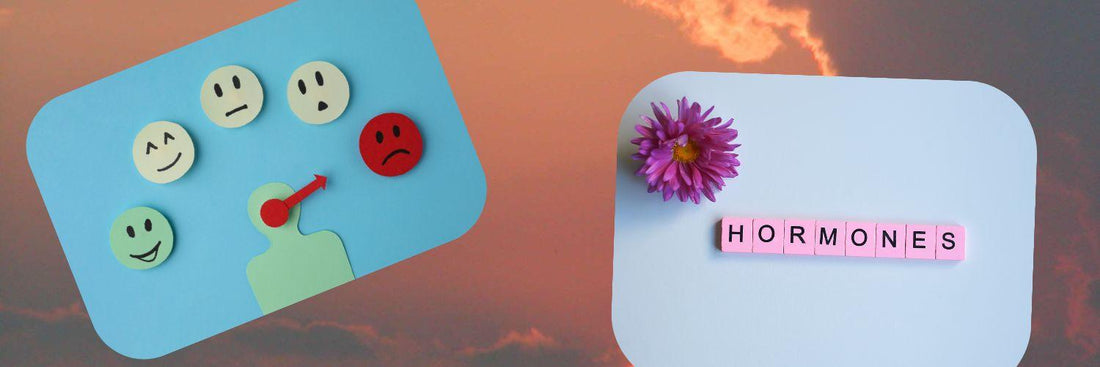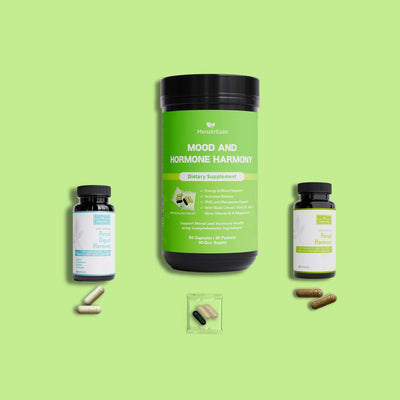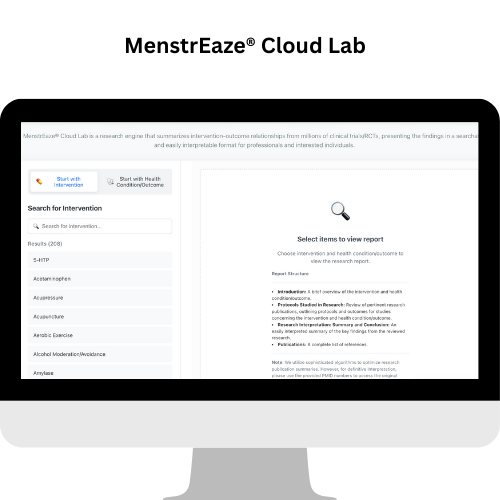Mood swings are a common experience among women, characterized by rapid and intense fluctuations in emotional states. While occasional mood changes are a normal part of life, severe or persistent mood swings can significantly impact daily functioning and quality of life. A critical factor contributing to these mood fluctuations is hormonal imbalance. This blog delves into the scientific explanations behind why women may suffer from mood swings, focusing on hormonal influences across different age groups, including premenstrual syndrome (PMS), perimenopause, and menopause.
1. The Role of Hormones in Mood Regulation
1.1 Key Hormones Affecting Mood
Hormones are chemical messengers produced by endocrine glands that regulate various bodily functions, including mood. The primary hormones influencing mood in women are:
- Estrogen: Produced mainly in the ovaries, estrogen modulates neurotransmitter systems such as serotonin, dopamine, and norepinephrine, which are crucial for mood regulation.
- Progesterone: Also produced in the ovaries, progesterone has a calming effect but can cause mood disturbances when levels fluctuate.
- Testosterone: Although present in lower amounts in women, testosterone influences mood, energy levels, and libido.
- Thyroid Hormones: Regulate metabolism and energy; imbalances can lead to mood disorders like depression or anxiety.
1.2 Hormones and Neurotransmitters
Hormones interact with neurotransmitters—the brain's chemical messengers—to influence mood and emotional responses. For instance:
- Estrogen and Serotonin: Estrogen increases the production and availability of serotonin, a neurotransmitter associated with feelings of well-being and happiness.
- Progesterone and GABA: Progesterone metabolites enhance the effect of gamma-aminobutyric acid (GABA), an inhibitory neurotransmitter that promotes relaxation and reduces anxiety.

2. Mood Swings During Adolescence
2.1 Puberty and Hormonal Changes
Adolescence marks a significant hormonal upheaval as the body prepares for reproductive maturity. The hypothalamic-pituitary-gonadal (HPG) axis becomes active, leading to increased production of estrogen and progesterone.
2.2 Impact on Mood and Emotional Regulation
- Emotional Sensitivity: Fluctuating hormone levels can heighten emotional responses, making adolescents more sensitive to stress.
- Brain Development: The prefrontal cortex, responsible for impulse control and emotional regulation, is still developing, contributing to mood instability.
3. Premenstrual Syndrome (PMS)
3.1 Definition and Prevalence
PMS refers to a group of physical and emotional symptoms occurring in the luteal phase of the menstrual cycle. Symptoms include irritability, depression, anxiety, and mood swings.
3.2 Hormonal Fluctuations During the Menstrual Cycle
- Follicular Phase: Estrogen levels rise, promoting the thickening of the uterine lining.
- Ovulation: A surge in luteinizing hormone triggers ovulation.
- Luteal Phase: Progesterone levels increase, preparing the uterus for possible pregnancy. If fertilization doesn't occur, estrogen and progesterone levels decline sharply.
3.3 How Hormonal Changes Cause Mood Swings in PMS
- Estrogen Withdrawal: The sudden drop in estrogen can decrease serotonin levels, leading to mood disturbances.
- Progesterone Sensitivity: Some women may be more sensitive to progesterone fluctuations, affecting GABAergic activity and causing anxiety or irritability.
4. Mood Swings in Reproductive-Age Women
4.1 Hormonal Shifts
- Pregnancy: Estrogen and progesterone levels rise exponentially to support fetal development.
- Postpartum: After delivery, these hormone levels drop dramatically.
4.2 Impact on Mood
- Pregnancy: High hormone levels can cause emotional lability.
- Postpartum Depression (PPD): The rapid hormonal decline postpartum is linked to mood disorders like PPD.
5. Perimenopause
5.1 Definition and Hormonal Changes
Perimenopause is the transitional period before menopause, typically occurring in women aged 40-50. It is characterized by irregular menstrual cycles and fluctuating hormone levels.
5.2 Impact on Mood
- Estrogen Fluctuations: Erratic estrogen levels can lead to mood swings, depression, and anxiety.
- Sleep Disturbances: Hot flashes and night sweats disrupt sleep, exacerbating mood disorders.
6. Menopause
6.1 Hormonal Changes During Menopause
Menopause is defined as the cessation of menstruation for 12 consecutive months. It involves:
- Decline in Estrogen and Progesterone: Ovarian function diminishes, leading to low hormone levels.
- Increase in Follicle-Stimulating Hormone (FSH): The pituitary gland increases FSH production in response to declining estrogen.
6.2 Mood Swings and Menopause
- Depression and Anxiety: Lower estrogen levels can decrease serotonin and other mood-stabilizing neurotransmitters.
- Irritability and Fatigue: Hormonal changes can lead to physical symptoms that impact mood.
7. Hormonal Imbalances and Mood Disorders
7.1 Polycystic Ovary Syndrome (PCOS)
- Hormonal Profile: Elevated androgens (male hormones) and insulin resistance.
- Mood Impact: Higher rates of depression and anxiety due to hormonal and metabolic disturbances.
7.2 Thyroid Disorders
- Hypothyroidism: Low thyroid hormone levels can cause depression, fatigue, and cognitive slowing.
- Hyperthyroidism: Excess thyroid hormones may lead to anxiety, irritability, and restlessness.
8. Neurobiological Mechanisms
8.1 Interaction Between Hormones and Neurotransmitters
- Serotonin: Modulated by estrogen; influences mood, sleep, and appetite.
- Dopamine: Affected by estrogen and progesterone; involved in reward and motivation.
- GABA: Enhanced by progesterone metabolites; promotes relaxation.
8.2 Brain Regions Affected
- Amygdala: Involved in emotional processing; sensitive to hormonal changes.
- Prefrontal Cortex: Governs executive functions and impulse control; influenced by estrogen levels.
9. How to Support Mood
Understanding the hormonal influences on mood swings is a crucial step toward managing them effectively. Various strategies can help support mood and enhance emotional well-being across different life stages. These approaches range from lifestyle modifications to medical interventions and psychological support.
9.1 Lifestyle Changes
9.1.1 Diet and Nutrition
- Balanced Diet: Consuming a diet rich in whole grains, lean proteins, fruits, and vegetables can support neurotransmitter production and hormonal balance.
- Omega-3 Fatty Acids: Foods high in omega-3s, such as fatty fish, flaxseeds, and walnuts, have been linked to improved mood and reduced symptoms of depression.
- Limit Caffeine and Alcohol: Reducing intake of stimulants and depressants can help stabilize mood fluctuations.
9.1.2 Exercise and Physical Activity
- Regular Exercise: Engaging in physical activity releases endorphins, natural mood elevators that can alleviate symptoms of depression and anxiety.
- Mind-Body Practices: Activities like yoga and tai chi combine physical movement with mindfulness, promoting relaxation and emotional balance.
9.2 Stress Management Techniques
9.2.1 Mindfulness and Meditation
- Mindfulness Practices: Techniques that focus on the present moment can reduce stress and improve emotional regulation.
- Meditation: Regular meditation can decrease anxiety and promote a sense of calm.
9.2.2 Cognitive Behavioral Strategies
- Journaling: Writing down thoughts and feelings can help identify triggers and patterns related to mood swings.
- Relaxation Techniques: Deep breathing exercises and progressive muscle relaxation can mitigate stress responses.
9.3 Sleep Hygiene
- Consistent Sleep Schedule: Maintaining regular sleep and wake times supports hormonal regulation and mood stability.
- Sleep Environment: Creating a comfortable, dark, and quiet sleep environment can improve sleep quality.
- Limit Screen Time: Reducing exposure to screens before bedtime can enhance melatonin production and facilitate better sleep.
9.4 Medical Treatments
Consultation with Healthcare Providers
- Hormone Therapy: In some cases, hormone replacement therapy (HRT) may be recommended to balance estrogen and progesterone levels, particularly during perimenopause and menopause.
- Medications: Antidepressants or anti-anxiety medications may be prescribed to manage severe mood disorders.
- Addressing Underlying Conditions: Treating hormonal disorders like thyroid imbalances or PCOS can alleviate mood-related symptoms.
9.5 Psychotherapy and Counseling
9.5.1 Cognitive Behavioral Therapy (CBT)
- CBT Techniques: CBT can help individuals identify and modify negative thought patterns that contribute to mood swings.
- Emotion Regulation Skills: Learning coping strategies can enhance resilience against hormonal mood fluctuations.
9.5.2 Support Groups
- Peer Support: Joining groups with others experiencing similar challenges can provide emotional support and practical advice.
- Professional Guidance: Counselors and therapists can offer strategies tailored to individual needs.
9. 6 Alternative Therapies
Supplements
- Phytoestrogens: Plant-based compounds found in soy and flaxseed may mimic estrogen effects and help balance hormones.
- St. John's Wort: Some evidence suggests it may alleviate mild to moderate depression, but it should be used under medical supervision due to potential interactions.
- Chamomile (Matricaria chamomilla): Research has investigated chamomile for its potential therapeutic effects on mood disorders, sleep disturbances, and pain management.
- 5-HTP (5-Hydroxytryptophan): Studies show that 5-HTP, a natural amino acid, can effectively regulate serotonin levels, offering benefits for depression, obesity, insomnia, migraines, and anxiety. It also acts as a potent antioxidant, protecting against free-radical damage and potentially aiding in the treatment of neurological and metabolic disorders.
- GABA (Gamma-Aminobutyric Acid): Research indicates that GABA plays a significant role in mood disorders, highlighting its function in regulating neuronal excitability and promoting relaxation.
- Calcium: Supplementary calcium (1,000 mg daily for four weeks) has been shown to improve mood in participants without depressive disorders compared to a placebo. This suggests calcium's potential therapeutic role in treating depressive disorders, supported by its importance in neuronal activity and its effect on monoaminergic neurons involved in mood regulation.
- Magnesium: Extensive in vivo and in vitro studies recognize magnesium as a potent "physiological mood stabilizer," emphasizing its effectiveness in mood regulation.
- Folic Acid and Vitamin B12: Research suggests that folic acid and vitamin B12 should be considered in the treatment of depression, as they may play a role in alleviating depressive symptoms.

9.7 Social Support
Building Strong Relationships
- Communication: Open discussions with friends and family about emotional experiences can foster understanding and support.
- Community Involvement: Engaging in social activities and volunteering can enhance mood and provide a sense of purpose.
10. Conclusion
Mood swings in women are intricately linked to hormonal imbalances that occur naturally throughout different life stages. Understanding the scientific mechanisms behind these mood fluctuations empowers women and healthcare providers to recognize symptoms and seek appropriate interventions. Hormones like estrogen and progesterone play a pivotal role in modulating neurotransmitter systems that regulate mood. By addressing hormonal imbalances through lifestyle changes, medical treatments, and psychological support, women can achieve better emotional well-being.






